Hand Rearing Piglets
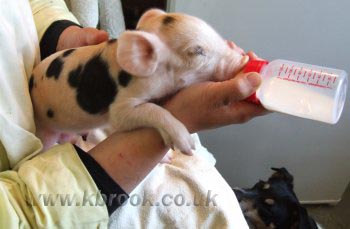
What I would say is, “don’t do it” if you value your marriage, social life and love your sleep! But if you are a soft touch and see that there is a life to save then who are you to deny it the right and so my story begins.
Hand rearing piglets is hard work and if the piglet can be reintroduced back to the sow then I would encourage you to try your best to do so.
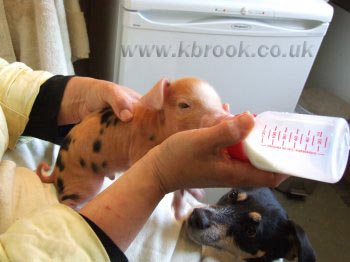
My introduction to the hand rearing of piglets began one April evening. My sow started to farrow and all was going as normal until the last one to came out. A little gilt who was very small and needed a rub and mucus taking out of her mouth to get her started. I didn’t think she would make it but eventually she coughed and spluttered so I helped her to a teat where she sucked with great gusto, so she was a fighter and I was going to help her all I could. Her only problem was that she was not quick on her feet and therefore unable to move when the sow got up to move around.
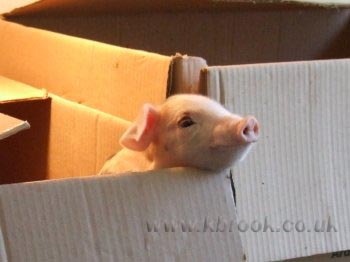
All the litter had fed well, but during their fourth feed I noticed that the litter was covered with blood. It transpired that a piglet who’s umbilical cord had broken too near to the stomach was continuously bleeding and covering the others whilst he was clambering over them for his share at the milk bar. I applied pressure to the umbilical cord but this didn’t seem to work. He proceeded to weaken and squeal in frustration, causing everybody including the sow to get agitated so he was taken away and put into the house in a box under a heat lamp – I didn’t have much hope for him but when entering the house at 06:00 hrs the following morning found he was up and perky (thanks to my husband for feeding him in the middle of the night). So I took him back out to reintroduce him to the sow who told me quite nicely after three attempts that she didn’t want him. After staying out all night with the little runty girl and putting her on the teat every 20 minutes with the rest of the litter, she still wasn't strong enough to feed herself so I had two piglets to bring up.

I always keep full fat goats milk around farrowing time, so for the first 48 hours the two piglets (Agatha and Geoffrey) were fed every 20 minutes with warmed goats milk and thereafter every 2 hours.
After every feed they were kept in the utility room in a cardboard box with an old towel or two for comfort, but it was soon clear that this was not adequate so during the day they had the freedom of the kitchen, sleeping by the Rayburn on the dogs bed – very patient dogs I have. At night they were tucked up in their box with a soft toy (soppy I know) in the utility room. As they grew in confidence, which doesn’t take long they were allowed out of the house to run around the garden and then wondered back in the house to sleep by the Rayburn – exhausting work running around the garden.
In the evenings when I was having my sneaky break the hand reared piglets sniffed me out in the front room to tell me it was their feeding time, it was so sweet to see but you should have seen my husbands face “piglets in the front room!” I am smiling now thinking of it.


Feeding
Goats milk is best as it has has a very high fat content, but try and get sow replacement powdered milk called Volac Faramate Sow Replacement Milk. This can also be obtained from your local farm supply shop or vets. If you have to wait for the sow replacement to arrive then you can feed piglets on human baby milk, but do try not to keep them on it for too long as by week 2 (which was how long I had to wait for my sow replacement milk to arrive) their skin will become flaky and scour (diarrohea) will set in.
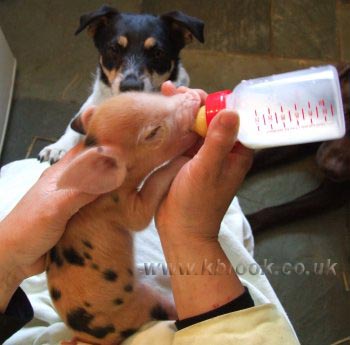
During the early stages up to two weeks feeding up to 50ml every two hours is sufficient, they may not drink it all but start off in increments of 10ml. If they ask for more then up their next feed – this will coincide with the size of the piglet, a larger piglet will drink more than a smaller one. You will find at night time they will not feed as much. I found that with the last feed being at 23:00 hrs, their next feed would be at 03:00 hrs. However, in their first week I am afraid that every two hours must be adhered too. At three weeks start to introduce concentrates, a good piglet starter pellet. Allen & Page Smallholder Range is normally best as it has a high milk content in the pellets. Again, your local farm supply shop will be able to provide this for you.
Don’t despair if they do not take to it straightaway. Keep a bowl of fresh water nearby and a few pellets in a bowl and watch them learn. The same can be done for the milk but when you are hand rearing piglets this all becomes very messy so I am afraid I fed them with a Royal Canin puppy bottle, which had a perfect teat size and both were much happier this way. Also this way I was able to monitor exactly how much each was consuming.
Introducing the hand reared piglets to the outside
As you may imagine by week four everybody (apart from me) including the dogs were getting a little fed up of these pesky little sweeties. I found it all very satisfying and rewarding, but even a friend told me that I was going above and beyond the call of duty even though they were trained to use puppy training pads when they wanted to go to the loo.

So my hand reared piglets were introduced to outside living. A wooden box was made and placed just outside so I could keep a watchful eye on them. There was nothing to worry about it was fine, the weather was beautiful for them the sun was shining and they enjoyed their rootling. Even though my husband is very proud of his lawn he had to relent. The piglets would shout at me when I passed and wanted to follow but the single electric wire kept them in and they soon learned that life outside away from me wasn’t that bad really. They also learned to drink the milk from the bowl but were still not too enamoured about the concentrates UNTIL I introduced a few blueberries to the bowl and Eureka they started eating concentrates. I fed them four times a day – little and often. They grew very well, but not as well as their siblings who where being brought up by the sow, which goes to show that mothers milk is best.
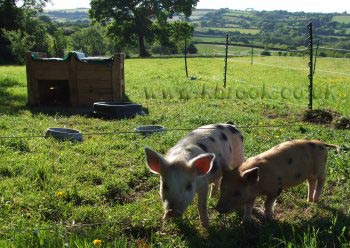
I did experience a fright one morning, as I looked out of my bedroom window I noticed that the gilt was out of her box standing at the fence alone and I know she never ventures out without her brother, so where was he? Quickly I dressed ran down the stairs still unable to see him from the downstairs windows ran to the back door and there through the glass I saw this little piglet standing at the backdoor waiting to come in. As I opened the door the cheeky blighter ran in and plonked himself down in front of the Rayburn. So I deduced from this that they would not have gone far. Mind you my neighbours did chuckle and warn me not to be surprised if they found their way home once they'd been sold to their new homes! So far so good but I'm still holding my breath!
 At eight weeks they were off to their new homes, at complete ease when picked up and put into their carrying crate. They rather enjoyed being carried. A little cuddle and a snuggle into your neck was just the tonic!
At eight weeks they were off to their new homes, at complete ease when picked up and put into their carrying crate. They rather enjoyed being carried. A little cuddle and a snuggle into your neck was just the tonic!
I can say that it was a very satisfying, rewarding achievement and when asked, “would you do it again?”... Absolutely, without a shadow of a doubt!
Hand Rearing Piglets Guide
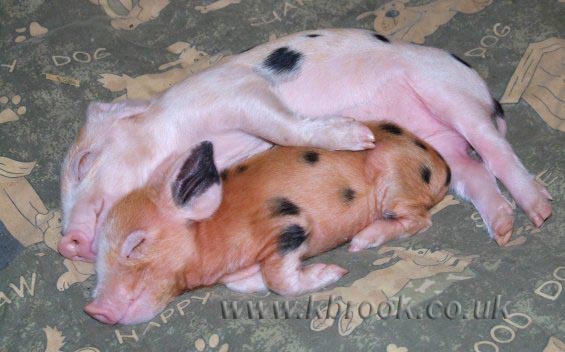
- Make sure that the piglets have had some colostrum (this is a requirement as it is rich in antibodies and minerals to help them fight bacteria).
- Keep them warm as the natural body temperature of a piglet is 34ºC.
- The hand reared piglet will suckle from a bottle automatically if it has been suckling its mother. If this is not the case then persist by gently massaging the teat whilst in the mouth. They will soon realise what is on offer.
- Iron is a mineral that all pigs require, if you are hand rearing the piglet give them a 2ml injection within the first three days of birth.
- Feed every 20 minutes for 48 hours. These first 48 hours are crucial to their survival. The feeding times ensure their interest in feeding and suckling, leaving it too long they become disinterested, weak and lethargic.
- The hand reared piglet will consume up to 20ml per feed in the first 48 hours. It may look like they haven’t had anything at first but they will have had sufficient. This is why feeding every 20 minutes will help them to latch on and become enthusiastic. Yes you can place the milk in a bowl and encourage them to lap it up you must be persistent and patient. When the milk becomes cold they are not interested.
- Day three and the hand reared piglets can now be fed every two hours. You will find as the days progress and by the end of day seven they will be suckling very well and taking up to 40ml (this is dependent on size and weight of piglet). Even if they finish all the milk do not let them dictate to you that they want more as this will bloat them and make them feel uncomfortable – again assess the size of the piglet.
- After one week the hand reared piglets will be demanding and telling you when it is their feed time. Keep to two hours and they will most probably be feeding up to 40ml to 50ml. You will now find the night time feed will be less but don’t worry as they will soon be feeding and making up for what they missed that night in their early morning feed.
- At three and a half weeks start introducing pig starter pellets (pencils not cobs) and place in a bowl, next to a bowl of fresh water and still provide milk. You can try to feed the milk in a tray where they will learn to lap it up, but will get very angry and frustrated, as they will be looking to you for the feed. At this stage it is up to you whether you carry on with the bottle or let them lap it up. The choice is yours but it is easier for all concerned if they do learn.
- If the weather is fine take them outside. Have a draught proof pen for them. In a barn for a week will help whereby you will place the food in the bowl and provide warm milk. Walk out and leave them and they will soon learn.
- By four weeks the hand reared piglet should be outside, eating the grass, rootling and foraging and gaining the minerals from the earth.
- Feed them the concentrates at least four times a day, little and often is the trick. If you find that they are still not interested then introduce some fruit, not apples, blueberries (rich in vitamins) or chopped up dried apricots.
- Your hand reared piglets will be thriving, may not be as big as their siblings, but will be strong, characterful and ready to go at eight weeks.
- Sit down with a glass of wine and relish the experience and give yourself and almighty big pat on the back!